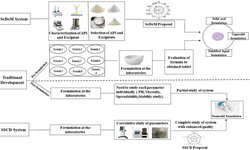Scientific papers
Mesoporous silica facilitates the conversion of liquids into solids due to its high capacity to load liquid or dissolved active ingredients, enhancing dissolution properties. However, compressing both unloaded and loaded mesoporous silica into tablets is challenging due to its poor or nonexistent binding capacity. This issue becomes significant when aiming for high drug loads, as the proportion of additional excipients in the final tablet formulation needs to be minimized. This study explored the compression mechanism and tabletability based on the Liquid Load Level of the silica and the type of filler/binder in binary tablet mixtures. Selected fillers/binders—Vivapur® 101, FlowLac® 90, Pearlitol® 200 SD, and tricalcium citrate tetrahydrate—were mixed with Syloid® XDP 3050 at various Liquid Load Levels. Compaction characteristics were analyzed using the StylOne® Classic 105 ML compaction simulator. Additionally, a new critical quality attribute, the Overall Liquid Load (OLL), was introduced for liquisolid tablets. OLL provides a straightforward, formulation-relevant comparison across different fillers/binders, liquid components, and silica types. Results indicated that strong binding capacity and high plasticity of fillers/binders are crucial for successful high liquid load silica tablet formulations. A combination of 30% Vivapur® 101 and 70% Syloid® XDP 3050 loaded at 0.75 mL/g was the most effective, achieving an Overall Liquid Load of 36–41% [v/v] and maintaining a tensile strength of 1.5 N/mm² with various liquid vehicles.

Comments
No comments posted yet.
Add a comment















